Cow – The Universal symbol of Motherhood
Cow is an ideal animal in Deity Bramha’s creation. As per spiritual science, the four Purushārthas, namely, Dharma, Artha, Kāma, and Moksha can be acquired by serving the cow. While praising the cow, the principal Deities, namely, Bramha, Vishṇu and Shiva have narrated the following shloka:
त्वं माता सर्व देवानां त्वं च यज्ञस्य कारणम् ।
त्वं तीर्थ सर्वतीर्थानां नमस्तेस्तु सदानधे ।
Meaning: O Destroyer of sins! You are the mother of all Deities. You are the reason for yadnya (sacrificial fire). Among all Tirthas (Holy places), you are the holiest. I pay my obeisance to you.
Religious and spiritual importance of Cow
Cow is not a mere animal for Hindus. They consider Cow as an adobe of 33 crore Hindu Deities and hence Cow is considered as sacred in Hindu Dharma. Cow has been treated as auspicious and also a symbol of compassion and piousness. Cow is treated as the highest and most pious animal and is given the utmost importance, being at the apex in the Animal world. The belief is that one can attain salvation (Moksha) by worshipping the Cow and serving her and both Lord Krishna and Balram spearheaded the “Cow worship and preservation” culture. The first Jain Tirthankar, Adinath was also named as Vrashbh meaning ‘Oxen Sorub’. Of all beings, the Cow is treated, in India, as the most sacred and sanctified. This sense of the unique sacredness of the Cow is expressed in the works of ancient Indian Rishis (like in the Vedas, Smritis, Srutis and Puranas, etc., as well as in later literature and folklore.
So highly were cows held in esteem by the Society that there were days fixed in the yearly calendar for exclusive worship of the Cow. Three days prior to the festival of Deepavali is called “Bachvaras (Vasubaras), which is a festival when cows are offered “Pooja”. Dhanteras is a day when cows are worshipped along with Dhanwantari the Sage and the diety of medicine) Balipratipada or Padwa is celebrated the day after Deepavali when, in many parts of India, cows are ceremoniously worshipped. Not only cows, but bulls also, were, and still are, the objects of worship. The last day of the month of Shravan, called POLA, is a day when bulls are decorated and taken in a procession to a public place for collective worship, after which they are then taken from house to house where each family offers ‘pooja’. The day after this is celebrated as Children’s Pola, when the children decorate and worship the wooden idols of bull and take them in a procession to a public place.
What do Vēdās say about the cow?
1. As per the Vēdās, cow is considered as a Universal symbol
As per the Atharvavēda, 33 crore Deities reside inside the cow. While describing the Divine form of cow, Bhagawan Shrīkrushṇa has said,
‘धनूनामस्मि कामधुक’
In the ancient Rushikuls (Hermitage of Sages), Cow sēvā (service) was compulsory along with Guru-sēvā (Service unto the Guru).
-Vishwa Hindu Parishad Calendar – 2010.
2. Slay the Cow slaughterers. – Atharvavēda 1-16-4
यदि नो गां हमि यद्यश्वं यदि पूरुषम् ।
तं त्वा सीसेन विध्यामो यथा नोऽसो अवीरहा ॥
(अथर्ववेद १।१६।)
Meaning : If someone destroys our cows, horses or people, kill him with a bullet of lead.
Meaning (Hindi) : यदि हमारी गौ, घोड़े पुरुष का हनन करेगा तो तुझे शीशे की गोली से बेध देंगे, मार देंगे जिससे तू हननकर्त्ता न रहे । अर्थात् पशु, पक्षी आदि प्राणियों के वध करने वाले कसाई को वेद भगवान् गोली से मारने की आज्ञा देता है ।
वेदों में मांस खाने का निषेध इस रूप में किया है । मांस बिना पशुहिंसा के प्राप्त नहीं होता है । अश्व, गौ, अजा (बकरी), अवि (भेड़) आदि नाम लेकर पशुमात्र की हिंसा का निषेध किया है और द्विपद शब्द से पक्षियों के मारने का भी निषेध है।
3. Cow is like a mother for all those who are bachelors till the age of 25 years, a daughter for those who are 26 years old and a sister for those who are 48 years old. – Rugvēda 8-101
4. Cow brings well-being and purity in the house. She is a source of wealth and prosperity. – Atharvavēda 4-21-5
– Gou Karuna Nidhi, Rushi Dayanand Saraswati, Surajmal Tyagi, E- 370, A, Shastri Nagar, Ajmer, Rajsthan (‘Aryaniti’, 10.2.2011)
त्वष्टुं प्रजानां प्रथम जनित्रमग्ने मा हिंसीः परमे व्योमन् ॥
(यजुर्वेद अ० १२, मन्त्र ४०)
Meaning (Hindi) : इन ऊन रूपी बालों वाले भेड़, बकरी, ऊंट आदि चौपाये, पक्षी आदि दो पग वालों को मत मार ।
7. A guru, a teacher, a father, a mother, a brahmana, a cow and a yogi all should never be killed. – Manu-samhita, chapter 4, verse 162 (Ref. : www.bhagavad-gita.org)
8. मनुस्मृति के प्रमाण के अनुसार मांस न खाने का फल सौ अश्वमेध यज्ञों के समान बताया है ।
वर्षे वर्षेऽश्वमेधेन यो यजेत शतं समाः ।
मांसानि च न खादेद्यस्तयोः पुण्यफलं समम् ॥
मनुस्मृति ५।५३॥
Meaning (Hindi) : जो सौ वर्ष पर्यन्त प्रतिवर्ष अश्वमेध यज्ञ करता है और जो जीवन भर मांस नहीं खाता है, दोनों को समान फल मिलता है ।
अनुमन्ता विशसिता निहन्ता क्रयविक्रयी संस्कर्ता चोपहर्ता च खादकश्चेति घातकाः
मनुस्मृति ५।५१
Meaning : Those who permit slaying of animals; those who bring animals for slaughter; those who slaughter; those who sell meat; those who purchase meat; those who prepare dish out of it; those who serve that meat and those who eat are all murderers.
Meaning (Hindi) : मारने की आज्ञा देने वाला, पशु को मारने के लिए लेने वाला, बेचने वाला, पशु को मारने वाला, मांस को खरीदने और बेचने वाला, मांस को पकाने वाला और मांस खाने वाला यह सभी हत्यारे हैं ।
9. याज्ञवल्क्य स्मृति में लिखा है,
सर्वान् कामानवाप्नोति हयमेधफलं तथा ।
गृहेऽपि निवसन् विप्रो मुनिर्मांसविवर्जनात् ॥
(आचाराध्याय ७।१८०॥)
Meaning (Hindi) : विद्वान् विप्र सर्वकामनाओं तथा अश्वमेध यज्ञ के फल को प्राप्त होता है । ऐसा गृहस्थी जो मांस नहीं खाता, वह घर पर रहता हुआ भी मुनि कहलाता है ।
10. महाभारत मे भी मांस को निषेध बताया है
सुरां मत्स्यान्मधु मांसमासवकृसरौदनम् ।
धूर्तैः प्रवर्तितं ह्येतन्नैतद् वेदेषु कल्पितम् ॥
(शान्तिपर्व २६५।९॥)
Meaning (Hindi) : सुरा, मछली, मद्य, मांस, आसव, कृसरा आदि खाना धूर्तों ने प्रचलित किया है, वेद में इन पदार्थों के खाने-पीने का विधान नहीं है ।
जीवितुं यः स्वयं चेच्छेत् कथं सोऽन्यं प्रघातयेत् ।
यद्यदात्मनि चेच्छेत् तत्परस्यापि चिन्तयेत् ॥
(शान्तिपर्व २५९।२२॥)
Meaning (Hindi) : जो स्वयं जीने की इच्छा करता है, वह दूसरों को कैसे मारता है । प्राणी जैसा अपने लिये चाहता है, वैसा दूसरों के लिये भी वह चाहे । कोई मनुष्य यह नहीं चाहता कि कोई हिंसक पशु वा मनुष्य मुझे, मेरे बालबच्चों, इष्टमित्रों वा सगे सम्बन्धियों को किसी प्रकार का कष्ट दे वा हानि पहुंचाये अथवा प्राण ले लेवे, वा इनका मांस खाये । एक कसाई जो प्रतिदिन सैंकड़ों वा सहस्रों प्राणियों के गले पर खञ्जर चलाता है, आप उसको एक बहुत छोटी और बारीक सी सूई चुभोयें तो वह इसे कभी भी सहन नहीं करेगा । फिर अन्य प्राणियों की गर्दन काटने का अधिकार उसे कहां से मिल गया ? प्राणियों का हिंसक कसाई महापापी होता है ।
11.
अहिंसा परमो धर्मः सर्वप्राणभृतां वरः ।
(आदिपर्व ११।१३)
Meaning (Hindi) : किसी भी प्राणी को न मारना ही परमधर्म है ।
12.
अनृतं वा वदेद्वाचं न हिंस्यात्कथं च न ॥
(कर्णपर्व ६९।२३)
Meaning (Hindi) : मैं प्राणियों को न मारना ही सबसे उत्तम मानता हूँ । झूठ चाहे बोल दे, पर किसी की हिंसा न करे । यहाँ अहिंसा को सत्य से बढ़कर माना है । असत्य की अपेक्षा हिंसा से दूसरों को दुःख अधिक होता है क्योंकि सबको जीवन प्रिय है ।
13.
घातकः खादको वापि तथा यश्चानुमन्यते ।
यावन्ति तस्य रोमाणि तावदु वर्षाणि मञ्जति ॥
(अनुशासनपर्व ६४।४॥)
Meaning (Hindi) : मारनेवाला, खानेवाला, सम्मति देनेवाला – ये सब उतने वर्ष दुःख में डूबे रहते हैं जितने कि मरने वाले पशु के रोम होते हैं । अर्थात् मांसाहारी घातकादि लोग बहुत जन्मों तक भयंकर दुःखों को भोगते रहते हैं ।
How Shrīkrushṇa took care of the cows and its importance
We must realize how nicely Hindu Dharma has described the importance of looking after cows. As we were not able to properly look after cows, Shri Vishṇu incarnated in Dwāpāryug as Shrīkrushṇa and showed us how to look after cows. This mere act of Shrīkrushṇa was to show us that if we don’t take care of cows, we will lose our sanctity. Shrīkrushṇa showed us that there is so much power in cow’s milk, ghee and Panchagavya (A mixture of cow’s milk, curd, ghee, cow’s urine and cow dung), that by consuming these He became so powerful that was able to defeat the powerful demons who fed on meat. King Janak was told by his Guru Yagnyavalkya, that ‘it is essential to protect cows till our last breath.’ – H.H. Kane Maharaj, Narayangaon, Pune, Maharashtra (year 1991).
Cow’s milk never becomes impure !
When the calf drinks the milk of the mother cow, the milk does not become impure. Moon stores nectar and then showers it, similarly these Rohini cows give us milk which is produced from nectar. Just as air, fire, gold and nectar (which was drunk by Gods) never becomes impure, similarly, the milk of a cow which is drunk by her calf never becomes impure. (The implied meaning behind this is that, the white foam which drops from the calf’s mouth while having cow’s milk is not considered impure). (Mahabharat, Anushasanparva 77|24-26)’ (Hindvi, 14 to 13 March 2010)
Panchagavya – A Divine medicine
1. Panchagavya is an extremely pure medicine.
गव्यं पवित्रं च रसायनं च पथ्यं च हृद्यं बलबुद्धिकृत् स्यात् ।
आयुःप्रदं रक्तविकारहारी त्रिदोषहृद्रोगविषापहं स्यात् ॥
Meaning: Panchagavya is an extremely pure chemical. It is healthy when included in diet, gives joy to the heart, increases life span, strength and intellectual capability. It is the destroyer of the three doshās (The three defects as per Āyurveda). It also destroys all the impurities and disorders of blood. It can cure cardiac disorders. By consuming it, all physical, mental and psychological problems can be overcome. (Rishi Prasad, October 2009, Prushtha.27)
Due to consumption of Panchagavya, one becomes free from all the sins related to body, is able to have control over mind and becomes eligible for acquiring knowledge.. Therefore, it is said that, consumption of Panchagavya is very important. – H.H. Kane Maharaj, Narayangaon, Pune, Maharashtra.
Cow (Important as is the descendent of Kamdhenu cow)
1. Gomay(cow dung) : It absorbs the heat.
2. Gomutra : It has healing power.
3. Milk : It is easy to digest as a result it is used as a substitute for mother’s milk. It is not fattening.
4. Yoghurt : It destroys vāt. It increases strength.
5. Gogrut (ghee) : It is useful for eyes and on wounds.
Various constituents of Panchagavya
| Constituents | As per ‘Dharmasindhu’ granth
Quantity (%) |
As per ‘Bodhyan granth’
Quantity(%) |
As per Doctors with 80 years of experience
Quantity(%) |
|---|---|---|---|
| 1. Goghrut ( Ghee made from cow’s milk) | 8 | 1 | 2.5 |
| 2. Godadhi (Curd made from cow’s milk ) | 10 | 2 | 5 |
| 3. Liquid from cow-dung | 1 | 0.5 | 1.5 |
| 4. Gomutra (Cow’s urine) | 8 | 1 | 20 |
| 5. Cow’s milk | 1 | 3 | 10 |
| 6. Kushodak | 4 | 1 | – |
Effect of Cow on the economy and agriculture
Indian agriculture has variety. There is no farm-product that we don’t cultivate. Our land grows all kinds of grains, pulses, vegetables, fruits, flowers, cotton and silk.About 70% of our population has embraced agriculture as profession. Cattle are integral part of the huge canvas of agriculture. We use oxen to plough, to pick and move harvested crops, in irrigation, cow manure as fertiliser, and cow urine as insecticide.
Unique Role of Cow in Agriculture
1. In our country with small holdings and small scale farming, there is no better alternative to employing cattle in farming.
2. While ploughing, the oxen stride with gentle gait, not harming the surface of the earth, unlike tractors. Even as they plough the land, the oxen defecate and urinate, fertilising the land.
3. Cattle Manure : organic manure, green leaf manure, earth-worms, and slurry manure with cattle manure bond with the nature and make the land fertile. They do not create the challenge of chemical waste.
4. 99% of the insects in nature are beneficial to the system. Insecticides prepared from cow urine or well fermented butter milk do not affect these helpful insects.
5. Dung from one cow is adequate to fertilise 5 acres of land and its urine is can protect 10 acres of crop from insects. As per the Supreme Court, cow dung produced by one oxen can support a family for 4 years. Oxen do not pollute the atmosphere.
6. Fertilizers made from Cow-dung and Cow-urine increases the quality and yield of crops. Fertilizer made from Cow-dung saves water to the extent of 5-times compared to using other fertilizers.
Role of Cows and Bulls in economy
1. Cattle are India’s greatest natural resource. They eat only grass, which grows everywhere and generates more power than all of India’s generating plants. They also produce fuel, fertilizer, and nutrition in abundance.
2. India runs on bullock power. Some 15 million bullock carts move approximately 15 billion tons of goods across the nation. Newer studies in energetics have shown that bullocks do two-thirds of the work on the average farm. Electricity and fossil fuels account for only 10%. Bullocks not only pull heavy loads, but also grind the sugarcane and turn the linseed oil presses. Converting from bullocks to machinery would cost an estimated $30 billion plus maintenance and replacement costs.
3. The biggest energy contribution from cows and bulls is their dung. India’s cattle produce 800 million tons of manure every year. The Vedas explain that dung from cows is different from all other forms of excrement. Indian culture insists that if one comes in contact with the stool of any other animal, they must immediately take a bath. Even after passing stool oneself, bathing is necessary. But the cow’s dung, far from being contaminating, instead possesses antiseptic qualities. This has been verified by modern science. Not only is it free from bacteria, but it also does a good job of killing them. Believe it or not, it is every bit as good an antiseptic as Lysol or Mr. Clean.
4. Most of the dung is used for fertilizer at no cost to the farmer or to the world’s fossil fuel reserves. The remainder is used for fuel. It is odorless and burns without scorching, giving a slow, even heat. A housewife can count on leaving her pots unattended all day or return any time to a preheated griddle for short-order cooking. To replace dung with coal would cost India $1.5 billion per year.
Effect of Cow on the food
Today milk and milk products are most essential part of the food not only in India, but also in the whole world; due to the nutrients in them. A mother nursing her infant depends on cow’s milk for her own nourishment. A mother feeds her child for a year or two; then cow is lifelong refuge for us all. Cow feeds its own calf and spares plenty for us too.
Different popular beverages like coffee, tea, etc. require milk as an important ingredient. Scores of sweet dishes in India are milk based. Curd, butter, and ghee are essential part of Indian meal. Taste of items deep fried in ghee is unmatched. Butter milk quenches thirst in addition to being a base for many popular dishes in our cooking.
Importance of Cow Urine and Cow dung
Importance and medical use of Cow urine
Cow unine which has a unique place in Ayurveda, the ancient Indian system of medicine. Commenting on the chemistry of gau mutra, Cow urine is used to produce a whole range of ayurvedic drugs, especially to treat skin diseases like eczema. Besides, gau mutra is a well known disinfectant. Anti-septic property is also the attribute of cow dung or gobar which is mixed with clay to form a plastering medium for mud huts. It is a proven fact that mud huts plastered with gobar keeps insects and reptiles away. This is the reason why people in the countryside still store grain in huge earthen pots plastered with gobar and gau mutra to keep it free from insect manifestations.
In Mahabharat era Nakul was known as the famous cow urine therapist. Indians believe that cow urine enhances holiness and purity when spread in courtyard and home. Makes there is need to refocus, in a creative enterprise, on cow as a source of health, wealth and happiness. Cow urine has wonderful properties. It is used in purification of many strong poisons, sub poisons, metals, and sub metals, ras, maharas, and astrologist stones. Poisonous materials become poison less within 3 to 7 days if purified with it according to the Indian method.
Importance of cow dung
Ancient scripture state that “Suryaketu” nerve on cow’s back absorbs harmful radiations and cleanses atmosphere. Mere presence of cows is a great contribution to environment. India has approximately 30 crore cattle. Using their dung to produce bio gas, we can save 6.0 crore ton of firewood every year. This would arrest deforestation to that extent. African deserts were made fertile using cow dung. We can reduce acid content in water by treating it with cow dung.Hence we can say that cow dung has important role in preserving environment.
When we burn cow dung, it balances atmospheric temperature and kills germs in the air. Cow dung has antiseptic, anti radioactive and anti thermal properties. When we coat the walls and clean the floors of house with cow dung, it protects the dwellers. In 1984, gas leak in Bhopal killed more than 20,000 people. Those living in houses with cow dung coated walls were not affected. Atomic power centres in India and Russia even today use cow dung to shield radiation.
Cow dung fertiliser is important in helping to improve the structure of the soil(aggregation). Animal manure has been used for centuries as a fertiliser in farming, improving the soil structure so that it holds more nutrients and water and becomes more fertile. Animal manure also encourages soil microbial activity which promotes the soil’s trace mineral supply, improving plant nutrition. It also contains some nitrogen and other nutrients itself which assisst the growth of plants.
“Cows provide approx 100 million tonnes of dry dung a year costing Rs 5000 crores which saves 50 million tonnes of firewood which again means that many trees saved and more environmental damage prevented. It is calculated that if these 73 million animals were to be replaced, we would need 7.3 million tractors at the cost of 2.5 lac each which would amount to an investment of 180,000 crores. In addition 2 crore, 37 lakh and 50 thousand tonnes of diesel which would mean another 57,000 crore rupees. This is how much we owe these animals, and this is what we stand to lose by killing them.” – Maneka Gandhi
Effect of Cow Dung on the environment
Cow Dung is used in Agnihotra
1. As the paipal tree and holy basil plant give oxygen, similarly Cow is the only animal, which emits major amount of oxygen. If one spoon of pure ghee is poured on the burning cow cakes dung (fuel) then they can produce one-ton oxygen, therefore ghee made with cow milk is used in sacrificial fires and havans. There is no other better method to remove pollution.
2. India has approximately 30 crore cattle. Using their dung to produce bio gas, we can save 6.0 crore ton of firewood every year. This would arrest deforestation to that extent.

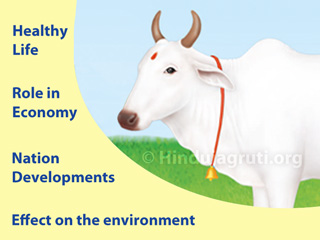
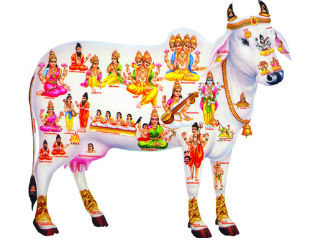 The hidden cost of beef eating
The hidden cost of beef eating How to contribute for protection of cows ?
How to contribute for protection of cows ?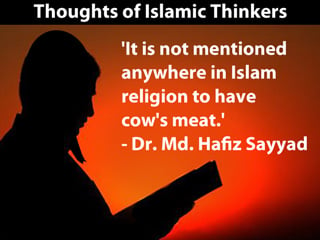 Thoughts of Islamic thinkers related to the protection of cows
Thoughts of Islamic thinkers related to the protection of cows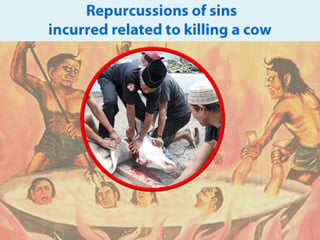 Sin incurred due to cow slaughtering and atonement for them
Sin incurred due to cow slaughtering and atonement for them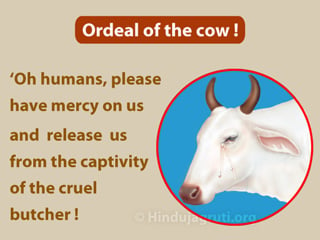 Heinous act of Cow slaughtering
Heinous act of Cow slaughtering